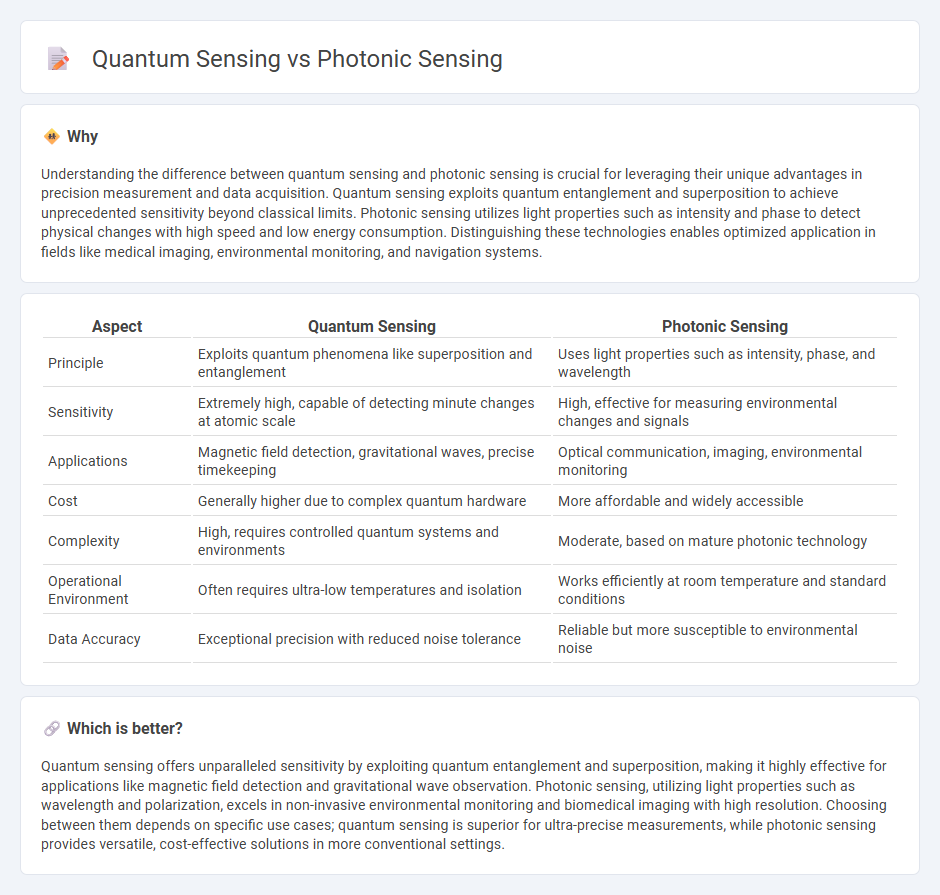
Quantum sensing leverages quantum phenomena such as superposition and entanglement to achieve ultra-sensitive measurements surpassing classical limits, enabling detection of minute physical changes with unprecedented precision. Photonic sensing employs light-based technologies like lasers and optical fibers to measure environmental parameters, offering high-speed, non-invasive, and accurate detection capabilities. Explore the advancements and practical applications of quantum and photonic sensing to understand their transformative impact on modern technology.
Why it is important
Understanding the difference between quantum sensing and photonic sensing is crucial for leveraging their unique advantages in precision measurement and data acquisition. Quantum sensing exploits quantum entanglement and superposition to achieve unprecedented sensitivity beyond classical limits. Photonic sensing utilizes light properties such as intensity and phase to detect physical changes with high speed and low energy consumption. Distinguishing these technologies enables optimized application in fields like medical imaging, environmental monitoring, and navigation systems.
Comparison Table
| Aspect | Quantum Sensing | Photonic Sensing |
|---|---|---|
| Principle | Exploits quantum phenomena like superposition and entanglement | Uses light properties such as intensity, phase, and wavelength |
| Sensitivity | Extremely high, capable of detecting minute changes at atomic scale | High, effective for measuring environmental changes and signals |
| Applications | Magnetic field detection, gravitational waves, precise timekeeping | Optical communication, imaging, environmental monitoring |
| Cost | Generally higher due to complex quantum hardware | More affordable and widely accessible |
| Complexity | High, requires controlled quantum systems and environments | Moderate, based on mature photonic technology |
| Operational Environment | Often requires ultra-low temperatures and isolation | Works efficiently at room temperature and standard conditions |
| Data Accuracy | Exceptional precision with reduced noise tolerance | Reliable but more susceptible to environmental noise |
Which is better?
Quantum sensing offers unparalleled sensitivity by exploiting quantum entanglement and superposition, making it highly effective for applications like magnetic field detection and gravitational wave observation. Photonic sensing, utilizing light properties such as wavelength and polarization, excels in non-invasive environmental monitoring and biomedical imaging with high resolution. Choosing between them depends on specific use cases; quantum sensing is superior for ultra-precise measurements, while photonic sensing provides versatile, cost-effective solutions in more conventional settings.
Connection
Quantum sensing and photonic sensing are interconnected through their reliance on the manipulation and detection of light particles, or photons, to achieve ultra-sensitive measurements beyond classical limits. Quantum sensing exploits quantum phenomena such as entanglement and superposition to enhance the precision of photon-based detection, enabling breakthroughs in fields like medical imaging, navigation, and environmental monitoring. Innovations in photonic sensing technology leverage quantum mechanics principles to improve sensor performance, providing critical advancements in accuracy and functionality across various scientific and industrial applications.
Key Terms
Photonic sensing:
Photonic sensing utilizes light particles to measure physical properties with high precision, making it suitable for applications in environmental monitoring, biomedical imaging, and telecommunications. Unlike quantum sensing, which exploits quantum phenomena like entanglement, photonic sensing relies on classical light manipulation techniques such as interferometry and spectroscopy. Explore the latest advancements in photonic sensing technology to understand its unique capabilities and applications.
Optical fibers
Optical fibers in photonic sensing leverage changes in light properties such as intensity, phase, or wavelength to detect environmental variables like temperature, strain, and pressure with high precision. Quantum sensing using optical fibers exploits quantum phenomena such as entanglement and superposition to achieve sensitivity beyond classical limits, enabling measurements at the nanoscale or single-photon level. Explore the unique advantages and applications of these cutting-edge technologies in fiber-based sensing.
Light detection
Photonic sensing leverages classical light properties such as intensity, wavelength, and phase to detect environmental changes with high spatial and temporal resolution. Quantum sensing exploits quantum states of light, including entanglement and superposition, enabling sensitivity beyond classical limits and improving precision in low-signal scenarios. Explore the unique advantages and applications of both photonic and quantum sensing technologies for advanced light detection.
Source and External Links
What is Photonic Quantum Sensing? - AZoOptics - Photonic quantum sensing uses quantum mechanics principles applied to photons, such as superposition and entanglement, to enable highly precise sensing and detection surpassing traditional optical methods.
A Review on Photonic Sensing Technologies: Status and Outlook - Photonic sensors detect changes in electromagnetic waves and convert them into electrical signals, utilizing devices like optical fibers, waveguides, plasmonics, and photonic crystals for applications in environmental and healthcare sensing.
Photonic chip integrates sensing and computing for ultrafast machine vision - Optica - A new photonic sensing-computing chip processes and reconstructs images within nanoseconds, enabling ultrafast, energy-efficient machine vision that combines sensing and computation for edge intelligence applications.
 dowidth.com
dowidth.com